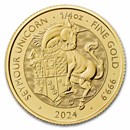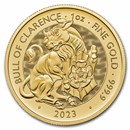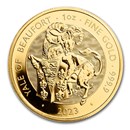British Gold Royal Tudor Beasts Coins
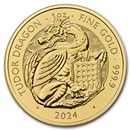
| Quantity | Check/Wire |
|---|---|
| 1 - 9 | $2,490.69 |
| 10 - 19 | $2,485.69 |
| 20 + | $2,480.69 |
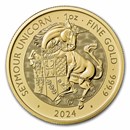
| Quantity | Check/Wire |
|---|---|
| 1 - 9 | $2,490.69 |
| 10 - 19 | $2,485.69 |
| 20 + | $2,480.69 |
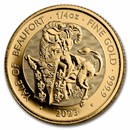
| Quantity | Check/Wire |
|---|---|
| 1 - 9 | $690.16 |
| 10 - 19 | $685.16 |
| 20 + | $680.16 |
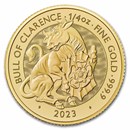
| Quantity | Check/Wire |
|---|---|
| 1 - 9 | $690.16 |
| 10 - 19 | $685.16 |
| 20 + | $680.16 |
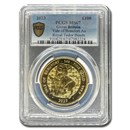

| Grade | Mintage | Population |
|---|---|---|
| N/A | 543 |
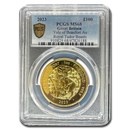

| Grade | Mintage | Population |
|---|---|---|
| N/A | 985 |


| Grade | Mintage | Population |
|---|---|---|
| N/A | 1,468 |
British Royal Tudor Beasts Gold Coins
The British Gold Royal Tudor Beasts Coins are a series of bullion coins issued by the Royal Mint in the United Kingdom. The series features designs inspired by the heraldic beasts that were present at the coronation of King Henry VIII in 1509.
Each Gold coin in the series features a different heraldic beast on the reverse side, and the obverse side features an effigy of Queen Elizabeth II. The beasts featured in the series include the Lion of England, the Griffin of Edward III, the Dragon of Wales, the Unicorn of Scotland, the Black Bull of Clarence, the Falcon of the Plantagenets, and the Yale of Beaufort.
The coins are minted in 1 oz, 1/2 oz, 1/4 oz, and 1/10 oz sizes, and are made from 99.99% pure gold. They are legal tender in the United Kingdom, with face values ranging from £10 to £100.
The series was first introduced in 2017 and has since become popular among collectors and investors. The design of each gold coin in the series is unique and the limited mintage makes them a valuable addition to any collection or investment portfolio.
The History of the Royal Mint
The Royal Mint is one of the oldest institutions in the United Kingdom, with a history dating back more than 1,100 years.
The earliest record of a mint in England dates back to the 8th century during the reign of King Offa of Mercia. However, it was not until the reign of William the Conqueror in the 11th century that a centralized mint was established in the Tower of London.
Over the centuries, the Royal Mint became responsible for producing and distributing coins and medals throughout the British Empire. The Mint was also responsible for refining and assaying precious metals, and for setting the standard weight and fineness of coins.
During the 19th and 20th centuries, the Mint underwent numerous changes, including the introduction of mechanized production methods and the transition from a government-run operation to a semi-autonomous agency. In 2009, the Royal Mint was transformed into a government-owned company, responsible for the production of coins and medals for the United Kingdom and other countries.
Today, the Royal Mint is one of the world's leading manufacturers of coins, medals, and bullion products. It also operates a visitor center in Llantrisant, Wales, where visitors can learn about the history of the Mint and see the production process in action.
The Seven Heraldic Beasts
The coronation of King Henry VIII in 1509 featured a procession of heraldic beasts, which were designed to represent the power and prestige of the Tudor monarchy. These beasts were based on traditional heraldic imagery, which had been used in England since the 12th century.
The seven heraldic beasts that were present at Henry VIII's coronation were:
- The Lion of England: This was the most important beast and represented the King's power and authority. The Lion was depicted holding a sword and a fleur-de-lis, symbolizing the King's claim to be the rightful heir of both the English and French thrones.
- The White Greyhound of Richmond: This beast represented the King's mother, Lady Margaret Beaufort, who was descended from the House of Lancaster. The White Greyhound was depicted wearing a collar with the initials "SR" (Sancte Rex) and holding a ragged staff, which was a symbol of the House of Lancaster.
- The Red Dragon of Wales: This beast represented the King's father, King Henry VII, who was of Welsh descent. The Red Dragon was depicted holding a green holly bush, which was a traditional Welsh emblem.
- The Black Bull of Clarence: This beast represented the King's great-grandfather, King Edward IV, who was a member of the House of York. The Black Bull was depicted wearing a golden crown and holding a white banner with the arms of the House of York.
- The Falcon of the Plantagenets: This beast represented the King's grandfather, King Edward III, who was a member of the House of Plantagenet. The Falcon was depicted holding a golden fetterlock, which was a symbol of the House of Lancaster.
- The White Lion of Mortimer: This beast represented the King's grandmother, Lady Anne Mortimer, who was descended from the House of Mortimer. The White Lion was depicted holding a white rose, which was a symbol of the House of York.
- The Yale of Beaufort: This beast represented the King's stepmother, Lady Elizabeth Stafford, who was married to Henry's father after his mother's death. The Yale was a mythical creature with the body of an antelope, the tusks of a boar, and the tail of a dragon. It was depicted holding a golden collar, which was a symbol of the Beaufort family.
These heraldic beasts have since become an important part of British heraldry and are still used in various official capacities, including on the British Royal Coat of Arms.

